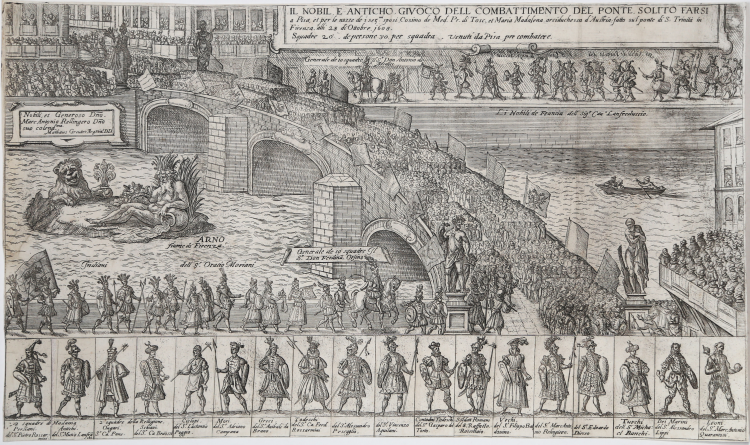




| Reference: | S43556 |
| Author | Mattheus GREUTER |
| Year: | 1608 |
| Measures: | 457 x 275 mm |



| Reference: | S43556 |
| Author | Mattheus GREUTER |
| Year: | 1608 |
| Measures: | 457 x 275 mm |
IL NOBILE E ANTICHO GIUOCO DELL COMBATTIMENTO DEL PONTE SOLITO FARSI a Pisa et per le nozze de i ser.mi sposi. Cosimo de Med. Pr. Di Tosc, et Maria Madalena arciduchessa d’Austria fatto sul Ponte di S. Trinità in Firenza alli 28 di Ottobre 1608. Squadre 26 di persone 30 per squadra, Venuti da Pisa per combattere.
Etching with engraving, 1608, signed on plate at upper left Nobili et Generoso Dno. Marc Antonio Rellingero Dno. Suo colend.mo. Mattaeus Greuter Arghent.s DD.
Greuter's work originated as an iconographic apparatus attached to L'Argonautica del S. Francesco Cini rappresentata in Arno per le nozze del sereniss. d. Cosimo de Medici. Principe di Toscana. E della serenissima arciduchessa Maria Maddalena d'Austria. In Firenze l'anno. 1608.
This is one of the numerous and now rare books of celebrations, published for the wedding of Cosimo II, eldest son of Ferdinand with Maria Magdalena of Austria, for which figurative documentation abounds, thanks above all to Ludovico Cigoli and Matthäus Greuter who, together with Remigio Cantagallina, translated Giulio Parigi's splendid set designs into print.
The event, celebrated in 1608, was much studied and detailed, in particular for the scenographic arrangements of the games, the public tournaments, for the choreographies of the ballets and in general for the theatrical performances in the Medici palaces that followed one after the other from 18 October, the date on which the new Grand Duchess made her triumphal entry into Florence, until 5 November, with the Giostra del Saracino contested in Piazza Santa Croce. Less fruitful, despite efforts, has been archive research so far on the derivative engravings, of which we cannot yet state with certainty whether they were directly commissioned by the court. The work of the German artist Matthaüs Greuter are in any case the two etchings illustrating, respectively, the grandiose and didactic Entrance to Florence of Maria Magdalena of Austria, which bears the dedication to Matteo Botti, Marquis of Campiglia, and the Grand Duke's 'Major Cathedral' followed by the similar Wedding Banquet, both attached to the Descrizione delle feste attributed to Camillo Rinuccini and published in Florence in 1608. In addition to these, the publication also included individual descriptions with the texts of the plays and ballets performed during those festivities, namely L'Argonautica by Francesco Cini, Ballo e Giostra dei Venti nelle nozze del serenissimo principe e della serenissima principessa di Toscana arciduchessa, by Lorenzo Franceschini, I cavalieri Sanesi e valorosi e cortesi professori d'arme, and finally the text of the theatrical performance La Notte d'Amore, again by Francesco Cini, which took place on the evening of 22 October in Palazzo Pitti. The publication was completed by other chalcographic engravings, in addition to the two already mentioned, including, by Greuter, La Giostra dei Venti, Il Nobil Anticho Giuoco del combattimento del Ponte solito farsi in Pisa and L'Argonautica; both mention the event of the wedding but are not dedicated to the Medici' (cf. Baroni, I Medici e l'incisione: Le origini della collezione di stampe degli Uffizi, 2008, pp. 39-41).
The Gioco del Ponte (Game of the Bridge) is an ancient Pisan tradition, based on the medieval Gioco del Mezzoscudo that took place in the Maritime Republic of Pisa. It began at the end of the 16th century at the behest of the Medici, who extended the practice of the chivalric spectacle to the entire Grand Duchy. The Game was played on the Ponte di Mezzo, which even then represented the central point of the city.
Beautiful proof, printed on contemporary laid paper, trimmed in copperplate, usual paper folds - due to the provenance of Cini's book - in good condition. Example applied on 'Japan' paper.
Bibliografia
Alessandra Baroni, I Medici e l’incisione: Le origini della collezione di stampe degli Uffizi, 2008, pp. 39-41, fig. 38.
Mattheus GREUTER (Roma 1564 - 1638)
|
Matthaus, or Mathias or Matheus, Greuter was drawer and engraver for De Angelis. He was born in Strassbourg in 1564 and died in Rome in 1638 and there he has been buried, in the church of Saint Eustachio.
Before coming to Rome, where he finally published his own works, he lived and worked for a while in Lion and Avignon. The majority of his plates are etchings with final touches with engraving, in “excellent style”. He remained in Rome until 1584.
He realized small engravings depicting saints and some title pages of maps and the great Giudizio Universale. He worked for Giovanni Mannozzi, Antonio Pomarancio, Claudio Deronet and, together with Lucas Vosterman, he realized the marvellous ride of Charles V.
|
Mattheus GREUTER (Roma 1564 - 1638)
|
Matthaus, or Mathias or Matheus, Greuter was drawer and engraver for De Angelis. He was born in Strassbourg in 1564 and died in Rome in 1638 and there he has been buried, in the church of Saint Eustachio.
Before coming to Rome, where he finally published his own works, he lived and worked for a while in Lion and Avignon. The majority of his plates are etchings with final touches with engraving, in “excellent style”. He remained in Rome until 1584.
He realized small engravings depicting saints and some title pages of maps and the great Giudizio Universale. He worked for Giovanni Mannozzi, Antonio Pomarancio, Claudio Deronet and, together with Lucas Vosterman, he realized the marvellous ride of Charles V.
|